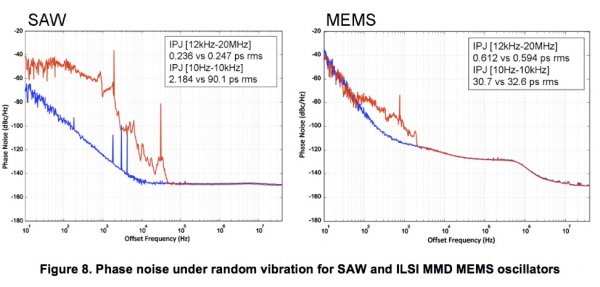1. The link is broken.
2. It seems the pics shows XOs (crystal oscilators) not MEMS.
So far, all the papers I was able to finds show that XO have much lower phase noise than MEMS. Which makes sense, as MEMS oscillators utilize a Phase Locked Loop (PLL) design with a MEMS resonator being phase locked to a VCO in an M/N synthesizer loop. The phase noise level of the MEMS oscillators is the result of the combined effects of the PLL loop bandwidth, selectivity of the VCO, and Q of the primary resonator. The quartz resonator (XO) device is operating at the output frequency and does not have the added noise signals of the PLL in the output.
The higher levels of phase noise demonstrate that MEMS oscillators are not an equivalent technology. Current communications and data transmission applications will very likely have problems with jitter at the levels indicated in the Agilent test system.
http://www.pletronics.com/getfile.php?id=401
1. Phase noise and phase jitter
We considered three frequencies (40MHz, 100MHz and 156.25 MHz) and compared Crystal oscillators to MEMS oscillators of the same frequencies. The Laboratory measurements demonstrate that the phase noise is much better with the Crystal oscillator than the MEMS oscillator for all frequencies.
http://geyer-electronic.de/fileadmi...of_Crystal_Oscillator_and_MEMS_Oscillator.pdf
Anyway, I would like to learn Andreas Koch rationele for using MEMS.
I just corrected the link. Your first quote is now eight years old, MEMs performance improved a lot since 2009. Anyway the key in the MEMs performance seems to be phase noise due to mechanical susceptibility, an hot subject in WBF.
IMHO, at this level of performance common technical parameters are usually of little value and should be regarded with great care - theoretically they result in inaudible differences.


